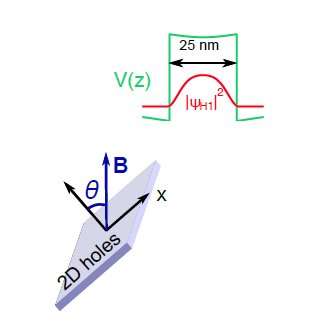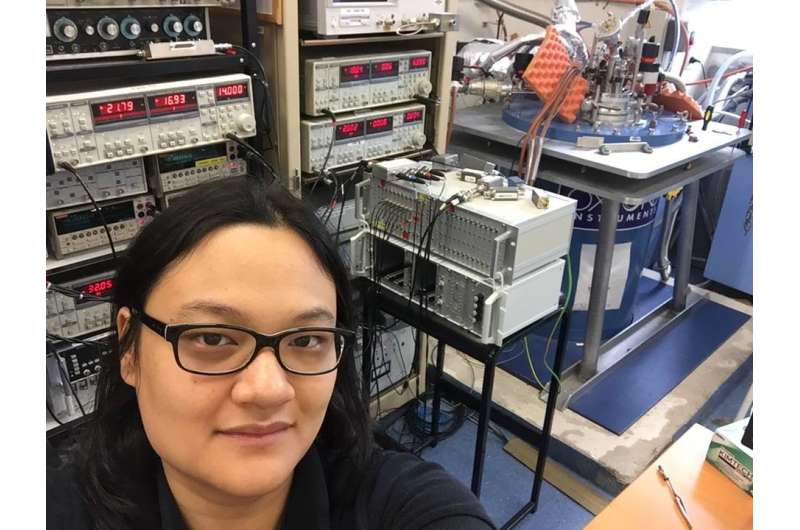Controlling hole spin for future quantum spin-based devices, topological materials

The 'spins' of electrons (and holes) in semiconductors have potential applications in spintronics, spin-based quantum computing, and topological systems.
A particle's spin is its intrinsic angular momentum.
In a magnetic field, the spins of electrons or holes becomes oriented either parallel ('spin-up') or anti-parallel ('spin-down') to the field direction – just like a compass needle.
These parallel and anti-parallel orientations have different energies, and it is this energy difference (known as Zeeman splitting if caused by a magnetic field) that holds the key to spin-based information processing.
In a paper published this week, FLEET researchers at UNSW have demonstrated an entirely new mechanism for electrically controlling holes' spin in a quantum well. The paper is featured this week in APS Physics.
Holes are quasiparticles, basically 'missing electrons' – a bit like the bubble in a spirit level, the missing chair in a game of musical chairs, or the missing player in a defensive backline. Sound a little esoteric? Well, half the transistors in your laptop or iPhone actually switch using the movement of positively-charged 'holes' – rather than negatively-charged electrons.
Where does spin fit in the puzzle then? To answer this, one needs to zoom into the atomic picture. In an atom, the spin-orbit interaction couples the electrons' (or holes') spin to their motion around the atom's nucleus. Because of this coupling, electrons (or holes) in motion 'sense' the electric field of the nucleus as an effective magnetic field, which then causes the electrons (or holes) to have two opposite spin orientations with an energy difference – an analogy of Zeeman splitting.

But that isn't the whole story: holes have very different spin properties than electrons. Unlike electrons, which are spin 1/2 particles, holes in semiconductors are spin 3/2 quasiparticles. This spin difference means holes react quite differently to an electric field or a magnetic field.
Spin-orbit interaction in holes is much stronger than in electrons, meaning that the energy difference between two opposite spin orientations is much larger and much more sensitive to electric fields in holes than in electrons. Thus, holes enable all-electrical spin manipulation which is very promising for ultra-low powered spin transistors, high-speed quantum bits, and fault-tolerant topological quantum bits.
In the study, the researchers demonstrated an entirely new mechanism for electrically controlling holes' spin in a quantum well, exploiting the unusual spin 3/2 nature of holes. Thanks to the strong spin-orbit interaction, the researchers showed that by solely using electric fields to increase the holes' momentum, the Zeeman splitting could be enhanced by as much as 300%.
The extreme tunability of the Zeeman splitting via electric fields opens new possibilities for future quantum spin-based devices, such as spin transistors, spin-orbit qubits, and quantum logic gates. It will also aid in realising Majorana systems in p-type superconductor systems, allowing one to drive the system into a topological regime under an external magnetic field without suppressing the superconductivity needed to support Majorana excitations.
The researchers also developed a new method for extracting the g-factor (quantifying Zeeman splitting) from magnetoresistance oscillations of two-dimensional holes, improving on conventional methods that fail for two-dimensional systems with strong spin-orbit interaction.
Finally, the ability to control the spin-orbit interaction is also key to developing new topological materials, which are currently being researched at FLEET for their potential to provide ultra-low resistance pathways for electrical currents.
The study Electrical Control of the Zeeman Spin Splitting in Two-dimensional Hole Systems was published in Physical Review Letters today, and was selected as an Editors' Suggestion, featured in Physics.
More information: E. Marcellina et al. Electrical Control of the Zeeman Spin Splitting in Two-Dimensional Hole Systems, Physical Review Letters (2018). DOI: 10.1103/PhysRevLett.121.077701
Journal information: Physical Review Letters
Provided by FLEET




















